Go的concurrency之context
context
context.Context是context包中的核心类型,它是一个上下文对象,用于跟踪和管理请求的生命周期。通过context.Context,你可以传递请求相关的值、设置取消信号以及控制截止时间。
使用context的主要目的是在并发操作中传递上下文信息,以便在整个操作链中共享和访问这些信息。
下面是一些常见的用法和特性:
创建上下文:可以使用
context.Background()函数创建一个根上下文,或使用context.WithCancel()、context.WithTimeout()和context.WithDeadline()等函数创建派生的上下文。传递上下文:将上下文对象作为参数传递给需要访问上下文信息的函数或方法。
获取上下文信息:可以使用
context.Value()方法从上下文中获取与键关联的值。取消操作:通过调用上下文的
cancel()函数,可以取消与上下文相关的操作。取消后,所有使用该上下文的goroutine都会收到取消信号。控制截止时间:可以使用上下文的
WithTimeout()或WithDeadline()函数来设置操作的截止时间。一旦超过截止时间,上下文会自动发送取消信号。
通过使用context包,你可以在并发操作中有效地管理资源、控制超时和取消操作。这对于构建健壮的并发应用程序非常有帮助。
以下是一个简单的示例,演示如何使用context进行取消操作:
1 | package main |
在上面的示例中,我们创建了一个带有取消功能的上下文,并在一个goroutine中执行一个模拟的耗时操作。然后,我们等待用户输入来触发取消操作,并调用cancel()函数取消操作。最后,我们等待一段时间以观察取消的效果。
通过使用context包,我们可以更好地管理并发操作,避免资源泄漏和无限等待的问题,以及提供更好的控制和可读性。
请求范围的上下文
在Go服务中,每个传入的请求都在其自己的 goroutine 中处理。请求处理程序通常启动额外的 goroutine 来访问其他后端,如数据库和 RPC 服务。处理请求的 goroutine 通常需要访问特定于用户(request-specific context)的值,例如最终哟过户的身份、授权令牌和请求的截止日期(deadline)。
当一个请求被取消或超时时,处理该请求的所有 goroutine 都应该快速退出(fail fast),这样系统就可以回收它们正在使用的任何资源。
Go 1.7 引入了一个 context 包,它使得跨 API 边界的请求范围元数据、取消信号和截止日期很容易传递给处理请求所涉及的所有 goroutine (显示传递,一般作为第一个参数)
其他语言:Thread Local Storage(TLS), XXXContext
例如一个跨进程请求

如何将 context 集成到 API 中?
在将 context 集成到 API 中时,它的作用域是请求级别的。例如,沿单个数据库查询存在是有意义的,但沿数据库对象存在则没有意义。
有意义:
1 | func Get(ctx context.Context,id uint) User { |
没有意义:
1 | type DB struct { |
目前有两种方法可以将 context 对象集成到 API 中:
Ths first parameter of a function call
首参数传递
context对象,比如,参考net包,Dialer.DialContext。此函数执行正常的Dial操作,但可以通过context对象取消函数调用。1
2
3
4
5
6
7
8
9
10
11
12
13
14
15
16
17
18
19
20
21
22
23
24
25
26func (d *Dialer) DialContext(ctx context.Context, network, address string) (Conn, error) {
if ctx == nil {
panic("nil context")
}
deadline := d.deadline(ctx, time.Now())
if !deadline.IsZero() {
if d, ok := ctx.Deadline(); !ok || deadline.Before(d) {
subCtx, cancel := context.WithDeadline(ctx, deadline)
defer cancel()
ctx = subCtx
}
}
if oldCancel := d.Cancel; oldCancel != nil {
subCtx, cancel := context.WithCancel(ctx)
defer cancel()
go func() {
select {
case <-oldCancel:
cancel()
case <-subCtx.Done():
}
}()
ctx = subCtx
}
...
}Optional config on a request structure
在第一个 request 对象中携带一个可选的 context 对象。例如
net/http库的Request.WithContext,通过携带给定的context对象,返回一个新的 Request 对象。1
2
3
4
5
6
7
8
9func (r *Request) WithContext(ctx context.Context) *Request {
if ctx == nil {
panic("nil context")
}
r2 := new(Request)
*r2 = *r
r2.ctx = ctx
return r2
}
不要将context存储在结构体中
Do not store Contexts inside a struct type;instead, pass a Context explicitly to each function that needs it.The Context should be the first parameter, typically named ctx:
2
3
// ... use ctx ...
}Incoming requests to a server should create a Context.
使用 context 的一个很好的心智模型是它应该在程序中流动,应该贯穿你的代码。者通常意味着您不希望将其存储在结构体之中。它从一个函数传递到另一个函数,并根据需要进行扩展。理想情况下,每个请求都会创建一个 context 对象,并在请求结束时过期。
不存储上下文的一个例外是,当您需要将它放入一个结构体中时,该结构纯粹用作通过通道传递的消息。如下例所示。
1 | type message struct { |
源码
context.WithValue
context.WithValue 内部基于 valueCtx 实现:
go/go1.19.6/src/context/context.go
1 | type valueCtx struct { |
为了实现不断的 WithValue ,构建新的 context,内部在查找 key 的时候,使用递归方式不断从当前,从父节点寻找匹配的key,直到 root context(Background 和 TODO context value 函数会返回 nil)
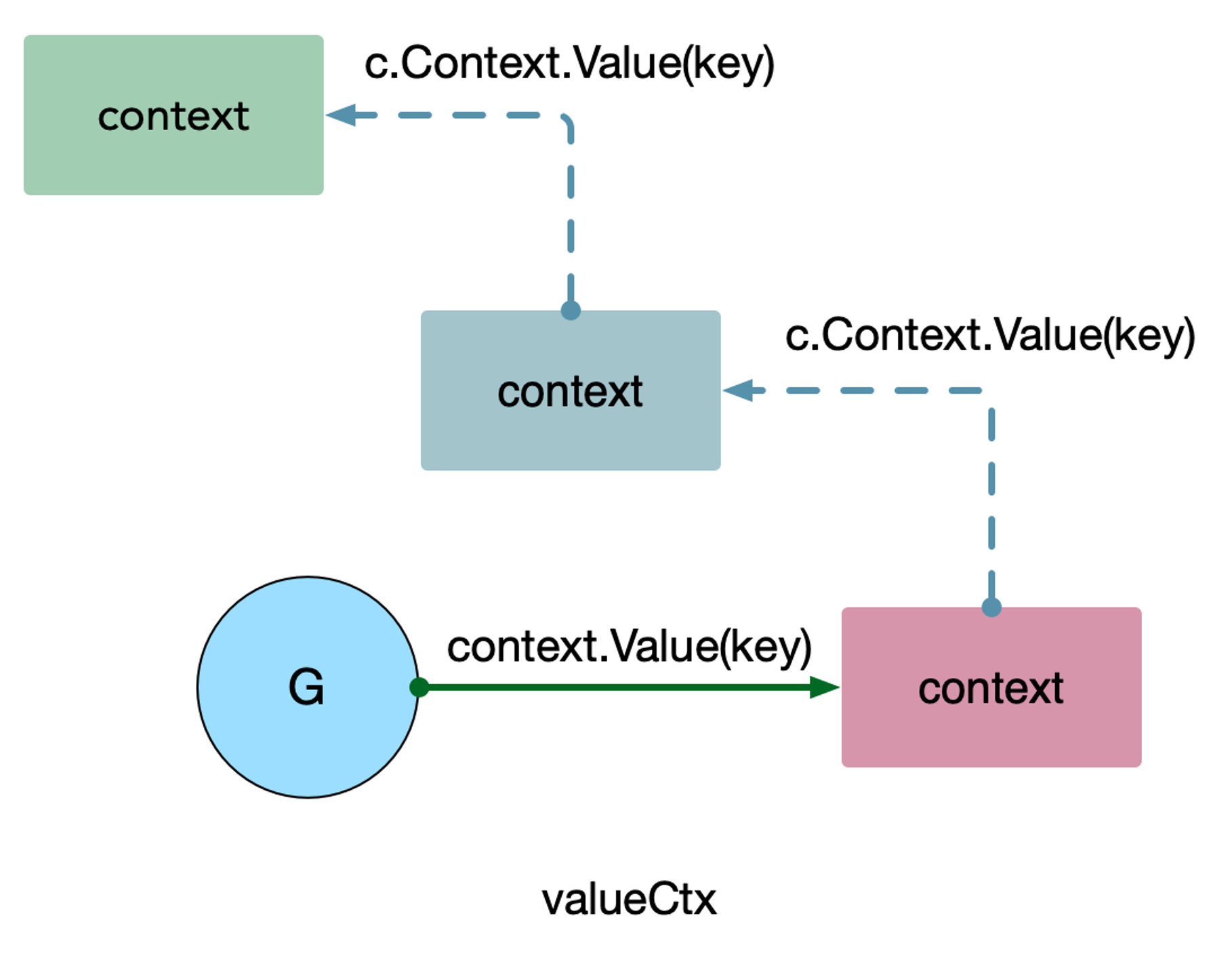
go/go1.19.6/src/context/context.go
1 | func (c *valueCtx) Value(key any) any { |
由于 ctx 会在不同的 goroutine 中传输,所以这些数据必须是安全的,这也就是 valueCtx 中只有一个 key 和 value 的原因,而且内容是只读的。
context.WithValue 方法允许上下文携带请求范围的数据。这些数据必须是安全的,以便多个 goroutine 同时使用。
这里的数据,更多是面向请求的元数据,不应该作为函数的可选参数来使用(比如 context 里面挂了一个 sql.Tx 对象,传递到 Dao 层使用),因为元数据相对函数参数更加是隐含的,面向请求的。而参数是更加显示的。
同一个
context对象可以传递给在不同 goroutine 中运行的函数;上下文对于多个 goroutine 同时使用时安全的。对于值类型最容易犯错的地方,在于context value应该是 immutable 的,每次重新赋值,应该是新的context,即:1
context.WithValue(ctx,oldvalue)
使用的思想可以借鉴gRPC metadata
Context.Value should inform, not control.
User Context values only for request-scoped data that transits processes and APIs, not for passing optional parameters to functions.
比如:染色,API 重要性,Trace
https://github.com/go-kratos/kratos/blob/v1.0.x/pkg/net/metadata/key.go
基于 gRPC 的 MD 思想存储数据到ctx
1 | func AppendToOutgoingContext(ctx context.Context, kv ...string) context.Context |
由于 context.WithValue 取值是需要一层一层往上查询的,而且每一个 context 都只能存储一个值,如果需要存储的值非常多,查询效率就会很慢。这个时候可以借鉴 gRPC 中的元数据MD
go/pkg/mod/google.golang.org/[email protected]/metadata/metadata.go
1 | type MD map[string][]string |
而且要保证多线程安全。
比如新建了一个基于 context.Background() 的 ctx1,携带了一个 map 的数据,map 中包含了 k1:v1 的一个键值对,ctx1 被两个 goroutine 同时使用作为函数签名传入。
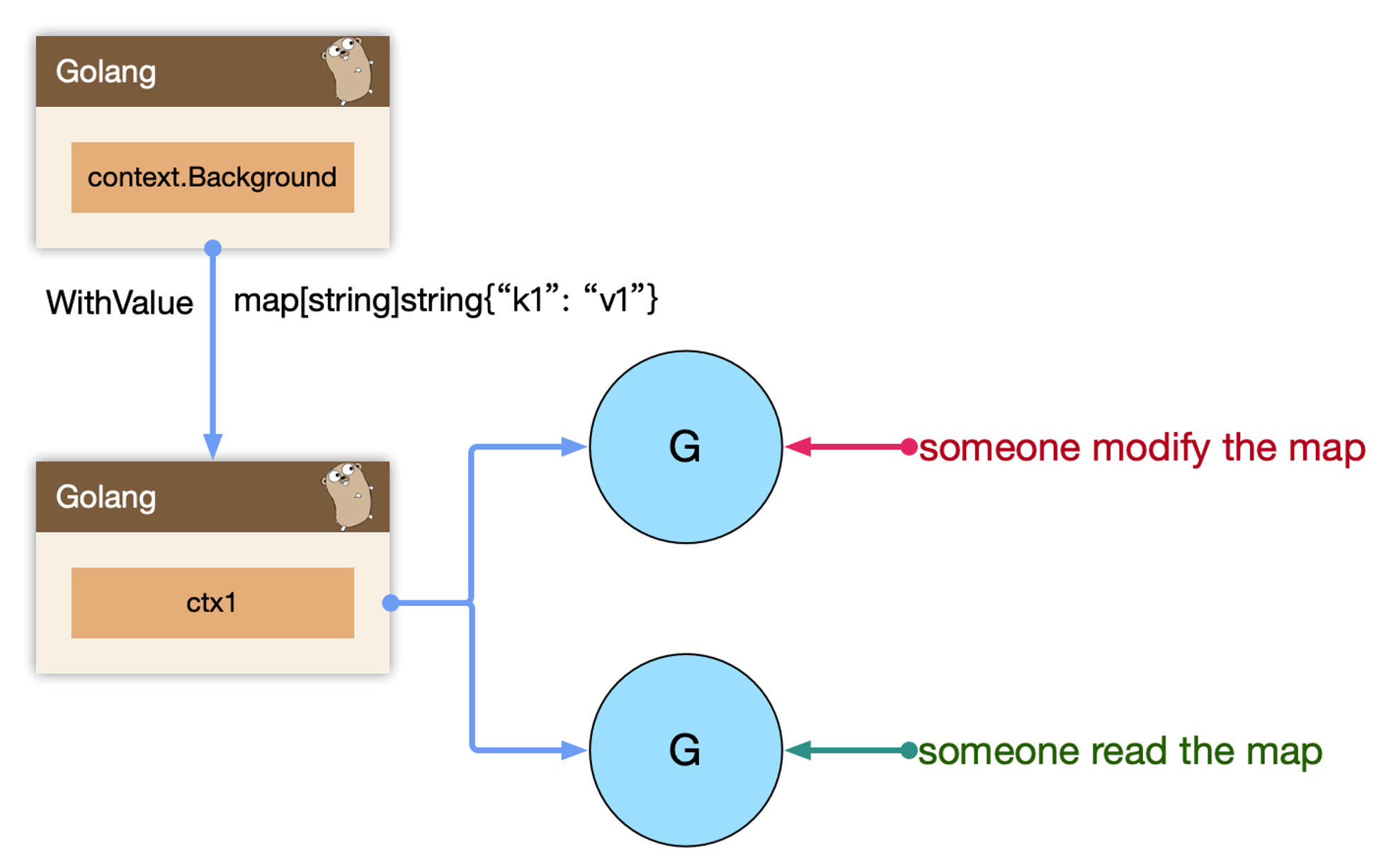
如果我们修改了这个 map ,会导致另外进行读 context.Value 的 goroutine 和修改 map 的 goroutine ,在 map 对象上产生 data race。因此我们要使用 copy-on-write的思路,解决跨多个 goroutine 使用数据、修改数据的场景。
Replace a Context using WithCancel, WithDeadline, WithTimeout, or WithValue.
比如 gin的 context,会在使用 Next() 的时候传递给下层,这样的设计不如 gRPC
1 | func (c *Context) Next() { |
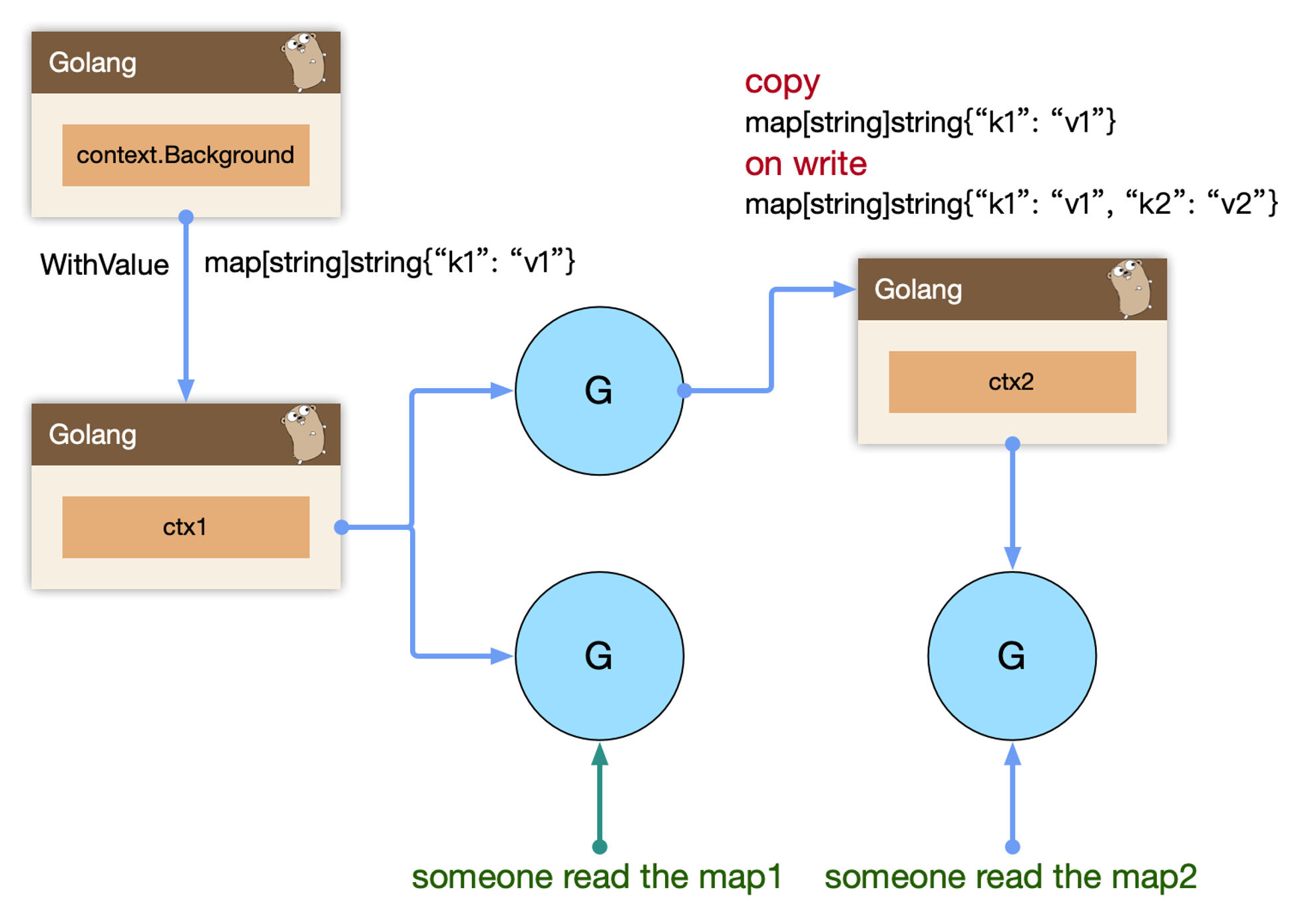
COW:从 ctx1 中获取 map1 (可以理解为 v1 版本的 map 数据)。构建一个新的 map 对象 map2,复制所有 map1 数据,同时追加新的数据 k2:v2键值对,使用 context.WithValue 创建新的 ctx2,ctx2 会传递到其他的 goroutine 中。这样各自读取的副本都是自己的数据,写行为追加的数据,在 ctx2 中也能完整读取到,同时也不会污染 ctx1 中的数据。
The chain of function calls between them must propagate the Context.
context.WithCancel
When a Context is canceled, all Contexts derived from it are also canceled.
当一个 context 被取消时,从它派生的所有 context 也将被取消。WithCancel(ctx) 参数 ctx 认为是 parent ctx,在内部会进行一个传递关系链的关联。
1 | // A cancelCtx can be canceled. When canceled, it also cancels any children |
Done() 返回一个 chan,当取消某个 parent context,实际上会递归层层 cancel 掉自己的 child context 的 done chan,从而让整儿调用链中所有监听 cancel 的 goroutine 退出。
1 | // This example demonstrates the use of a cancelable context to prevent a |
注意: defer cancel() // cancel when we are finished consuming integers 很重要,不 cancel() 可能会出现内存泄漏。
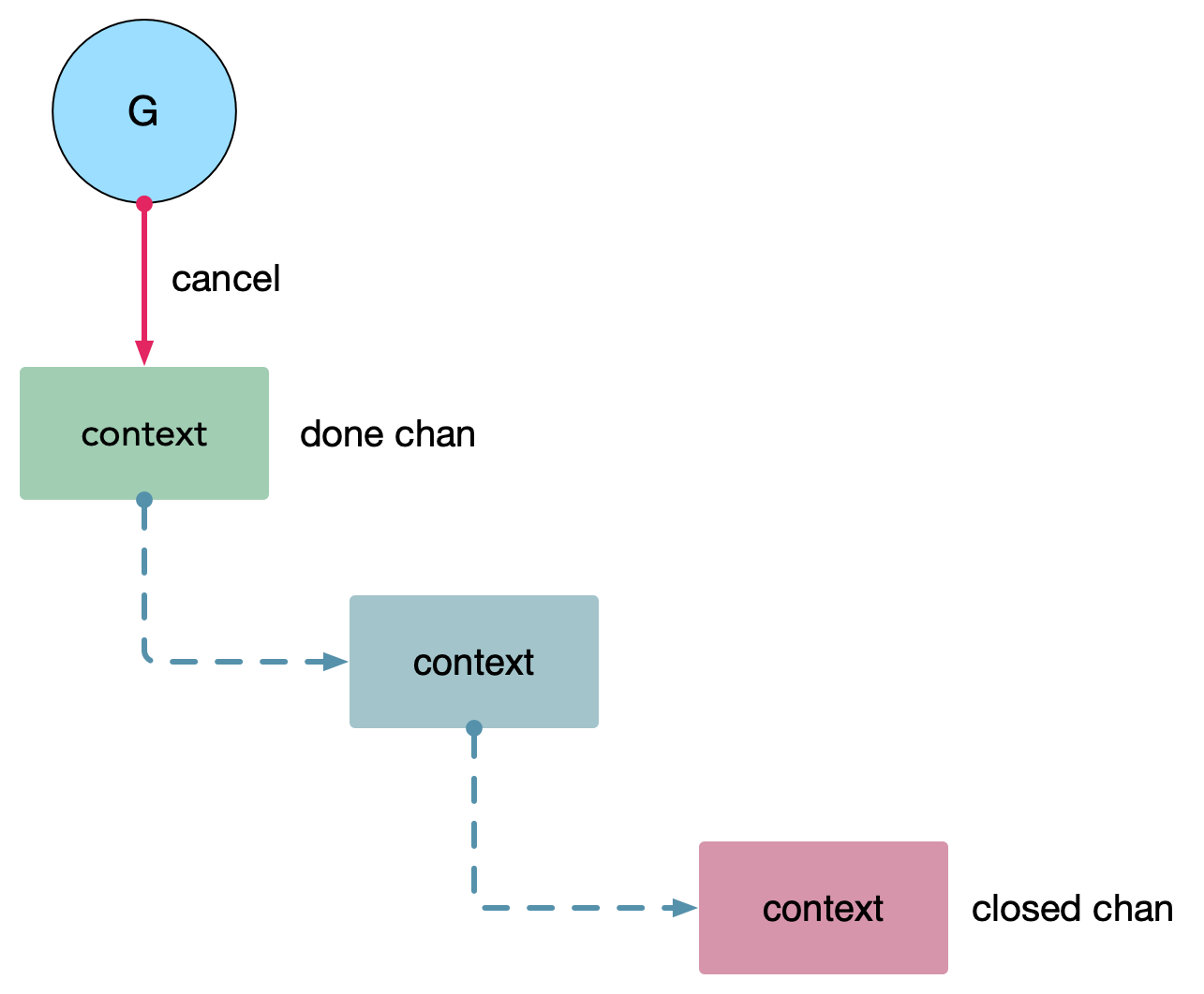
所有会阻塞的、长链路调用的操作都应该可以被取消。
All blocking/long operations should be canceled.
如果要实现一个超时控制,通过上面的 context 的 parent/child 机制,其实只需要启动一个定时器,然后在潮湿的时候,直接将当前的 context 给 cancel 掉,就可以实现监听在当前和下层的 context.Done() 的 goroutine 的退出。
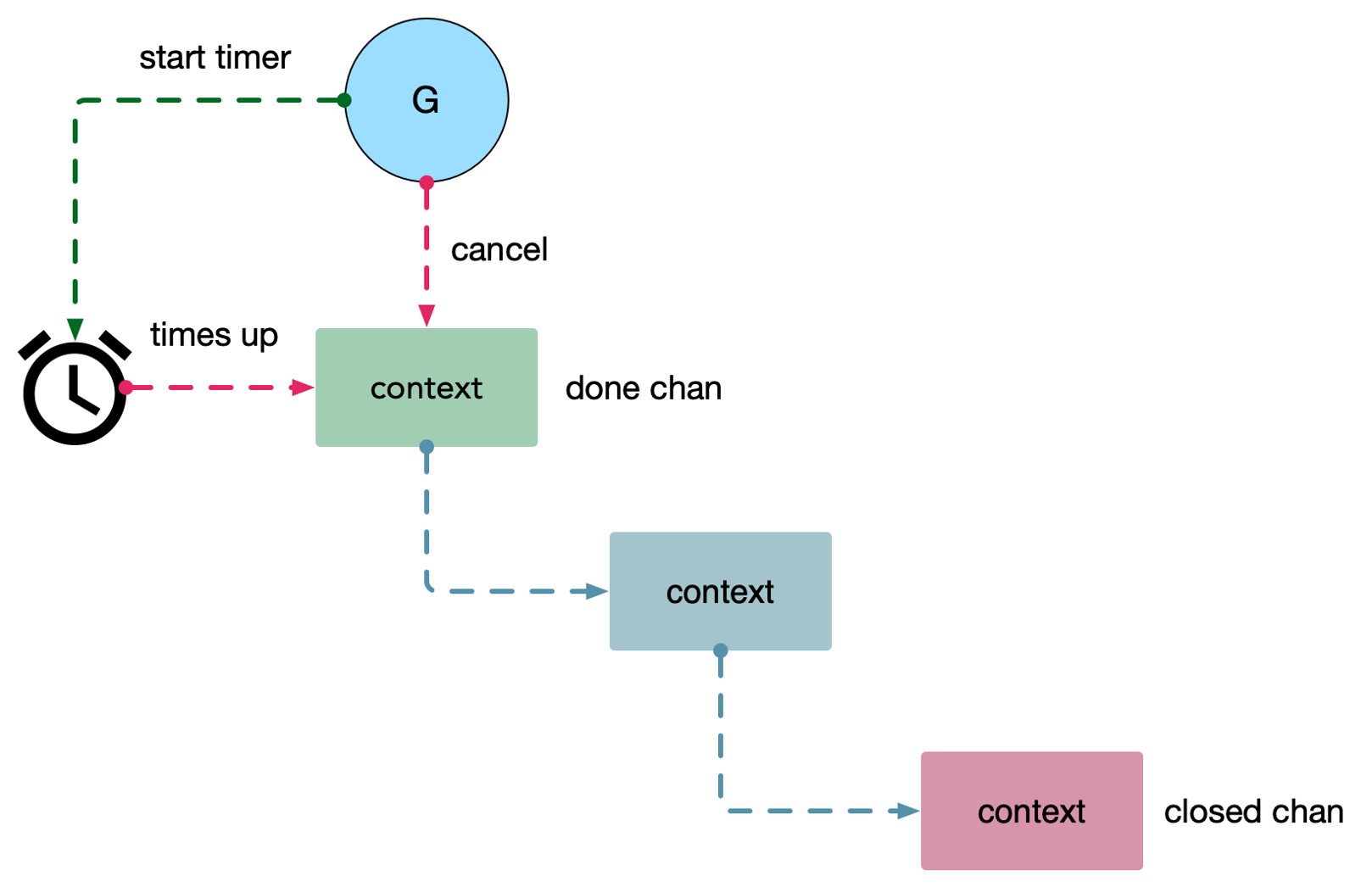
1 | // This example passes a context with an arbitrary deadline to tell a blocking |
Final Notes
Incoming requests to a server should create a Context.
对其他服务器的传入请求应该创建一个
ctx。Outgoing calls to servers should accept a Context.
对其他服务器的调用应传入一个
ctx。Do not store Contexts inside a struct type; instead, pass a Context explicitly to each function that needs it.
不要将
ctx存储在结构类型内,而应该将ctx显式传递给每个需要它的函数。The chain of function calls between them must propagate the Context.
函数之间的调用链必须传递
ctx。Replace a Context using WithCancel, WithDeadline, WithTimeout, or WithValue.
使用
WithCancel、WithDeadline、WithTimeout或WithValue创建新的ctx。When a Context is canceled, all Contexts derived from it are also canceled.
取消
ctx时,从中派生的所有ctx(child context)也将被取消。The same Context may be passed to functions running in different goroutines; Context are safe for simultaneous use by multiple goroutines
相同的
Context可以传递给在不同goroutine中运行的函数;ctx对于多个goroutine是线程安全的Do not pass a nil Context, even if a function permits it,Pass a TODO context if you are unsure about which Context to use.
即使函数允许,也不要传递
nil context。如果不确定要使用哪个ctx,请传递TODO ctx。Use context values only for request-scoped data that transits processes and APIs, not for passing optional parameters to functions.
仅对跨进程和API的请求范围的数据使用
context value,而不对函数间调用传递的可选参数使用context value。All blocking/long operations should be cancelable.
所有阻塞/耗时长的操作都应可取消。
Context.Value obscures your program’s flow.
使用
context.Value()方法获取上下文值可能会模糊程序的执行流程。Context.Value should inform, not contrl.
context.Value应该是路由逻辑,染色逻辑这种通知类的信息,而不是业务控制逻辑。Try not to use context.Value.
尽量不要使用
context.Value返回的
cancel要在defer中执行掉,不然会出现内存泄漏。
Cancellation, Context, and Plumbing
踩坑
这篇文章介绍的比较全面:Go Context的踩坑经历
基本上:注意闭包,不要将请求进来的 ctx 带 cancel 作为参数发送到异步的 goroutine 中。
参考
Go: Context and Cancellation by Propagation
Go Concurrency Patterns: Context
Context Package Semantics In Go
Go Context的踩坑经历
Cancellation, Context, and Plumbing
How to correctly use context.Context in Go 1.7